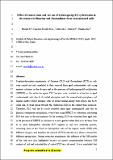Por favor, use este identificador para citar o enlazar a este item:
http://hdl.handle.net/10261/107688COMPARTIR / EXPORTAR:
 SHARE SHARE
 CORE
BASE CORE
BASE
|
|
| Visualizar otros formatos: MARC | Dublin Core | RDF | ORE | MODS | METS | DIDL | DATACITE | |

| Título: | Effect of contact time and the use of hydroxypropyl-β-cyclodextrin in the removal of fluorene and fluoranthene from contaminated soils |
Autor: | Morillo González, Esmeralda CSIC ORCID ; Sánchez Trujillo, Mª Antonia CSIC; Villaverde Capellán, J. CSIC ORCID ; Madrid Díaz, Fernando CSIC ORCID; Undabeytia López, Tomás CSIC ORCID | Palabras clave: | Organic matter quality Aged contaminated soil Extraction Sorption–desorption Cyclodextrins PAHs |
Fecha de publicación: | jul-2014 | Editor: | Elsevier | Citación: | Science of the Total Environment 496: 144- 154 (2014) | Resumen: | Sorption-desorption experiments of fluorene (FLU) and fluoranthene (FLT) in soils were carried out and correlated to their removal from aged contaminated soils using aqueous solutions in the absence and in the presence of hydroxypropyl-β-cyclodextrin (HPBCD) as the extraction agent. FLU became more resistant to extraction in aged contaminated soils due to its initial adsorption onto the mineral and amorphous soil organic matter (SOM) domains, sites of lower binding energy from which, due to its small size, it could spread towards the condensed SOM as the contact time increased. Therefore, FLU will not be easily desorbed from aged contaminated soils due to physical entrapment mechanisms, even when using HPBCD as extractant, presenting FLU low risks to the environment. On the contrary, FLT was extracted from aged soils in the presence of HPBCD in solutions to a much greater extent than in its absence. Due to its more hydrophobic character FLT sorption in soils was relatively quicker, remaining more or less fixed on hydrophobic sites of the organic matter (OM) with different energies, and therefore the amount of FLT extracted was almost constant for different ageing times. During extraction experiments, the influence of the OM quality of the soils was also highlighted because an inverse proportionality between OM content of soil and extractability of sorbed FLT was observed. It was concluded that soils with lower OM content that had more diagenetically processed OM could block the extraction of FLT more effectively than soils with higher OM content that are less humified. This indicates the need to use not only adsorption-desorption data in contaminant fate and transport models, but also extraction studies in aged contaminated soils and other complementary analytical approaches when assessing soil contamination-related risks. | Descripción: | 11 páginas.-- 4 figuras.-- 4 tablas.-- 60 referencias.-- 3 archivos docx (1 figura y 2 tablas) de material suplementario. | Versión del editor: | http://dx.doi.org/10.1016/j.scitotenv.2014.07.027 | URI: | http://hdl.handle.net/10261/107688 | DOI: | 10.1016/j.scitotenv.2014.07.027 | Identificadores: | doi: 10.1016/j.scitotenv.2014.07.027 issn: 1879-1026 |
| Aparece en las colecciones: | (IRNAS) Artículos |
Ficheros en este ítem:
| Fichero | Descripción | Tamaño | Formato | |
|---|---|---|---|---|
| Effect_contact_use_hydroxypropyl_comp..pdf | 1,33 MB | Adobe PDF |  Visualizar/Abrir |
CORE Recommender
SCOPUSTM
Citations
30
checked on 18-abr-2024
WEB OF SCIENCETM
Citations
28
checked on 25-feb-2024
Page view(s)
356
checked on 24-abr-2024
Download(s)
429
checked on 24-abr-2024
Google ScholarTM
Check
Altmetric
Altmetric
NOTA: Los ítems de Digital.CSIC están protegidos por copyright, con todos los derechos reservados, a menos que se indique lo contrario.
